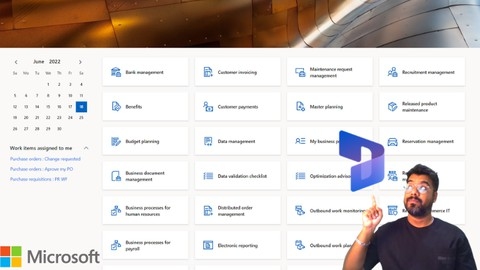Passing the Microsoft MB-310 exam can be a daunting task, especially with the vast amount of information needed to cover.
Finding a good course that covers the key topics in a structured and engaging way is essential for success.
Many people struggle with finding the right course, feeling overwhelmed by the sheer volume of options available.
After reviewing several Microsoft MB-310 courses, we believe that Dynamics 365 Finance&Operations: Financials Part2/3 MB-310 stands out as the best course overall.
This course provides a comprehensive understanding of core financial processes and entities within Dynamics 365 Finance & Operations.
It offers a practical learning experience, equipped with the skills needed to navigate and manage financial functions within the system.
This course focuses on practical exercises and real-world scenarios, making the learning process more engaging and effective.
However, if this specific course isn’t quite what you’re looking for, don’t worry!
We’ve compiled a list of other excellent Microsoft MB-310 courses on Udemy, covering various learning styles and preferences.
Keep reading to find the perfect course for your needs and embark on your journey to becoming a certified Dynamics 365 Finance expert.
Dynamics 365 Finance&Operations: Financials Part2/3 MB-310
This MB-310 course provides a solid foundation in Dynamics 365 Finance & Operations for beginners looking to grasp the fundamentals of financial management within the system.
The course takes a methodical approach, starting with the essential concepts of number sequences, which are crucial for tracking transactions and documents.
You’ll then delve into financial dimensions, a key element for categorizing and analyzing financial data effectively.
The course guides you through configuring account structures and defining valid dimension combinations.
These are essential skills for maintaining accurate financial records and analyzing financial performance within D365.
You’ll learn about journal names and journal control, discovering how to create various journal types, set posting restrictions, and create a secure system for your financial transactions.
The course also explores workflows, demonstrating how to automate and manage business processes efficiently.
You’ll learn about vendor and customer posting profiles, essential for controlling posting behavior for specific entities.
The course delves into the sales order cycle, including creating and posting free-text invoices and applying charges to sales orders.
You’ll also learn about creating charge codes and applying them to specific customers or items.
This course encompasses a comprehensive approach to Accounts Payable and Receivable, covering vendor payment journals and customer creation.
You’ll have the opportunity to practice creating trial balances and working with financial dimension sets.
Additionally, you’ll gain experience with configuring date intervals and understanding different workflow configurations.
By completing this course, you’ll gain a strong understanding of core financial processes and entities within Dynamics 365 Finance & Operations.
The course provides a practical learning experience, equipping you with the skills needed to navigate and manage financial functions within the system.
Dynamics 365 Finance&Operations: Financials Part3/3 MB-310
As the concluding part of a three-part series, this course assumes a foundational understanding of D365 F&O’s core financial concepts.
You’ll delve into complex scenarios, equipping you with the expertise to confidently navigate real-world financial challenges.
Imagine managing cash and bank accounts with ease.
This course empowers you to set up new bank accounts, configure check layouts for generating checks, and even send electronic payments to banks.
Bank reconciliation, both manual and automated, is explored in depth.
You’ll learn to import bank statements, navigate complex reconciliation scenarios, and master advanced techniques.
The course also delves into the intricate world of tax configuration.
From understanding tax authorities and settlement periods to mastering ledger posting groups and item sales tax groups, you’ll gain a comprehensive understanding of sales tax calculation and various methods of payment.
Expense management is covered from all angles.
You’ll master the creation and processing of expense reports, navigating both basic and advanced setups, including the implementation of streamlined workflows.
The course culminates with a thorough exploration of advanced general ledger topics.
You’ll gain a deep understanding of intercompany accounting, allocation terms, and foreign currency revaluation, equipping you to handle complex financial transactions.
Finally, you’ll delve into fixed asset management.
Learn how to configure assets, acquire them using journals, post depreciations, and handle disposal scenarios.
You’ll also master the use of posting profiles, parameters, and key reports for effective asset management.
MS Dynamics 365-Finance & Operations-MB300| 330 |310 (Part1)
This course offers a structured learning path that simulates a mini-implementation project, giving you hands-on experience with real-world scenarios.
You’ll start by understanding the core concept of legal entity creation, a fundamental building block in Dynamics 365.
The course delves into the setup of number sequences, essential for managing your business records.
It then moves on to the heart of your financial system - the Chart of Accounts, guiding you through configuring main accounts and establishing your ledger.
You’ll even learn how to leverage Excel for seamless data integration.
Moving beyond financial management, the course explores Product Information Management, a vital aspect of any business.
You’ll discover how to establish product relationships, work with different dimension groups (including storage, tracking, and product dimensions), and navigate category hierarchies.
You’ll dive deep into product attributes, released products, and the distinction between item model groups and item groups.
The course also demonstrates how to create product masters, including variations within a product, using real-life examples from industries like retail and automotive.
This course provides a robust foundation for understanding the core functionalities of Microsoft Dynamics 365 Finance and Operations.
The focus on practical application, coupled with clear explanations and real-world examples, makes it an effective resource for anyone seeking to excel in this area.
Part 2 | MS Dynamics365-Finance & Operations-MB300|330 |310
This course provides a comprehensive exploration of vendor management within Microsoft Dynamics 365 Finance and Operations.
You’ll gain a solid understanding of this crucial aspect of procurement, covering everything from fundamental vendor setup to advanced concepts like trade agreements and discount strategies.
You’ll learn to utilize features such as credit rating, credit limit, and vendor hold to effectively manage vendor interactions.
One of the strengths of this course is its in-depth exploration of charge codes and their various applications.
You’ll learn how to use charge codes to implement vendor rebates, automate charge code generation, and explore various scenarios for managing charges within purchase orders.
This knowledge will also be highly beneficial if you are preparing for the MB-310 exam, as vendor management is a significant component of the certification.
Part 3 | MS Dynamics365-Finance & Operations-MB300|330 |310
The course takes a step-by-step approach, beginning with the fundamentals of purchase order status, approval processes, and different purchase types.
You’ll gain a solid understanding of how to leverage filters and views to extract essential information from your purchase order data.
You’ll then dive into hands-on exercises, creating and processing purchase orders with detailed guidance.
The course emphasizes the importance of posting profiles, particularly for vendor and inventory management, ensuring you can accurately track your financial transactions.
Beyond the basics, you’ll delve into more complex aspects of purchase order management.
You’ll learn about adding multiple items and lines to orders, managing delivery schedules, and utilizing the copy functionality to streamline your workflow.
Supplementary items and their role in purchase orders are explained through clear examples, allowing you to apply this knowledge in real-world scenarios.
The course doesn’t shy away from the complexities of partial deliveries and receipts.
You’ll explore handling short closures, duplicate checks, and product receipt cancellations, all while understanding the intricacies of under and over deliveries.
Vendor reference numbers are discussed in detail, enabling you to effectively track your orders.
The course concludes with a strong emphasis on workflow setup.
You’ll learn to create your first purchase order using workflows, explore various options for purchase orders and batch jobs, and understand how to edit or reject orders within the workflow system.
Additionally, you’ll gain an understanding of the setup process, mandatory workflows, and the creation of purchase requisitions.
Part 4 | MS Dynamics365-Finance & Operations-MB300 |330 |310
This comprehensive course delves into the intricacies of advanced procurement and sourcing within Microsoft Dynamics 365 Finance and Operations.
You’ll gain a deep understanding of vendor evaluation, mastering the art of setting up criteria and effectively searching for the right vendors.
Beyond that, the course guides you through the entire RFQ process, from purchase requisition to implementation.
You’ll learn to craft and implement effective purchasing policies, ensuring compliance and optimal performance.
The course then shifts its focus to the nuances of purchase agreements, covering both quantity and value commitments.
You’ll discover how to seamlessly manage consignment warehouses, including setting up replenishment orders and managing inventory ownership changes.
The curriculum further explores vendor rebates, walking you through the setup process and showcasing real-world scenarios to solidify your understanding.
You’ll gain a thorough grasp of vendor returns and invoice matching validation, mastering the use of purchase orders and return orders to optimize your processes.
Finally, the course goes into the powerful Vendor Collaboration module.
You’ll learn the ins and outs of setup, master the sign-in process, and discover how to leverage this module for effective RFQ, purchase, and invoice management.
This course equips you with the practical knowledge and hands-on experience necessary to confidently navigate the complexities of advanced procurement and sourcing within Microsoft Dynamics 365 Finance and Operations.
Part 5 | MS Dynamics365-Finance & Operations-MB300 |330 |310
This course is a comprehensive deep dive into the world of inventory management within Microsoft Dynamics 365 Finance and Operations.
You’ll gain the essential skills needed to effectively manage your company’s inventory, and in doing so, gain a solid foundation for the MB-310 exam.
You’ll begin by understanding the foundational concepts of Sites, Warehouses, and Locations - the very backbone of tracking and managing your inventory.
Then, you’ll learn to set up inventory posting profiles for both purchase orders and sales orders, ensuring accurate and efficient recording of your transactions.
Next, you’ll delve into the complexities of Transfer Orders.
Learn about pre-requisite setups, cost management, and the complete process of creating Transfer Orders.
You’ll gain hands-on experience with reservations and partial deliveries, and master the art of handling under-delivery.
The course then guides you through the intricacies of Inventory Movement Journals, showing you how to set them up and utilize them for various inventory adjustments.
You’ll learn about costing within the context of movement journals, explore different scenarios to solidify your understanding, and uncover the key differences between inventory adjustment journals.
You’ll also dive into the concept of “Marking.”
Finally, you’ll be introduced to the Transfer Journal and learn how to effectively utilize it for various scenarios.
This course will equip you with the knowledge and skills necessary to confidently manage inventory within Microsoft Dynamics 365 Finance and Operations, positioning you for success in both your professional endeavors and your preparation for the MB-310 exam.
Part 6 |MS Dynamics 365-Finance & Operations-MB300 |330 |310
This course provides a comprehensive exploration of critical inventory management functionalities within Microsoft Dynamics 365 Finance and Operations.
You’ll gain a deep understanding of key areas like BOM journals, item arrival journals, counting journals, quality management, inventory blocking, and quarantine management – all essential for efficient supply chain operations.
You’ll start by mastering the intricacies of BOM journals, a crucial tool for managing your bill of materials.
You’ll learn the essential setup steps, understand the end-to-end process, and explore advanced scenarios.
From there, you’ll delve into item arrival journals, acquiring the skills to receive items efficiently, manage transfer orders, and ensure accurate inventory tracking.
Counting journals will become a familiar tool as you learn to set them up, apply reason codes, and even import data directly from Excel.
This course doesn’t shy away from the complexities of quality management, walking you through the process of creating test groups and tests, establishing quality associations, and navigating scenarios where a quality order fails.
Inventory control is a core theme, as you’ll explore various inventory blocking methods – from manual blocking to leveraging inventory status and batch disposition codes.
You’ll emerge from this course confident in your ability to effectively control inventory and prevent unnecessary delays.
Finally, you’ll gain a solid grasp of quarantine management, understanding its interaction with arrival journals and mastering the use of quarantine orders for various scenarios.








